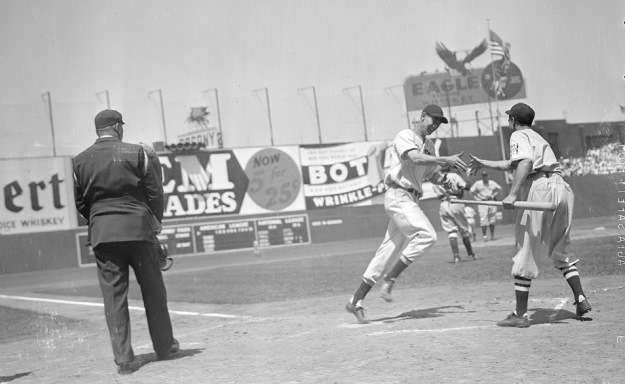A lone red seat in Fenway Park’s green bleacher section marks the longest home run ever hit by the greatest hitter ever to play for the Boston Red Sox.
True Red Sox fans know the story behind the red seat. But they may not know the whole story.
Ted Williams
Hall of Famer Ted Williams didn’t know whether he could pick up where he left off when he returned to the Red Sox in 1946 after spending 3-1/2 years in the Marine Corps during World War II.
He put those doubts to rest during a doubleheader at Fenway against Detroit on June 9, 1946
Williams got four hits in the first game. In the first inning of the second, he faced Fred Hutchinson and launched a ball into Section 42, Row 37, Seat 21 in the right-field bleachers. It was the longest home run ever hit in Fenway Park.
The ball traveled 502 feet and struck the straw hat of Joe Boucher, a 56-year-old construction engineer from Albany, N.Y. The ball careened off Boucher’s head and bounced a dozen rows higher. When Boucher took off his hat, he found the ball had put a hole in it.
‘Not Interested’
Boucher didn’t try to keep the ball, saying “after it hit my head, I was no longer interested.”
And he asked the Boston Globe, “How far away must one sit to be safe in this park?”
The next day the Globe ran a page one photo of Boucher sticking his finger through the hole in his straw hat. The caption read “Bullseye.”
“He threw me a changeup and I saw it coming,” Williams remembered. “I picked it up fast and I just whaled into it.”
Tigers catcher Paul Richards has a different memory of the game. He told the Atlanta Journal-Constitution he was in the dugout with Fred Hutchinson between the doubleheader games. Hutchinson said he didn’t care if Williams was a superstar, he wouldn’t let Williams hit like that.

Ted Williams in 1947.
After William’ blast, Hutchinson sat fuming in the clubhouse. Richards said, “You really showed that Williams.” Then, said Richards, ”Here comes a chair, flying at me, but I beat it to the door.”
Hurricane?
ESPN for its Home Run Tracker analyzed meteorological data and tested various models to figure out how far the ball would have flown had Boucher not been sitting in the way. Analysts concluded the ball would have traveled 530 feet before landing on the ground, since the impact point was approximately 30 feet above field level had it not hit Joseph Boucher.
Physicist Alan Nathan said the ball would have gone 535 feet. Meteorological records showed him the temperature that day was 76 degrees and the wind came 21 mph from the west. He figured Williams hit the ball at an unusually steep angle of 30.3 degrees and that the ball’s speed off the bat was 119.4 mph. Based on those assumptions, the ball would have gone five feet farther than the ESPN analysts thought.

The Boston Red Sox’ Big Papi, David Ortiz.
No one has come close, not even slugger David Ortiz. Ortiz himself said a hurricane would have had to carry a ball that far.
The Red Sox eventually replaced the bleacher bench where Boucher sat. Then in 1984 Red Sox owner Haywood Sullivan decided to install a red plastic seat to commemorate Williams’ mighty blast.
Boucher’s grandson, William McGuire, later said you couldn’t find a more devoted Red Sox fan than his grandfather. “If they ever tear down Fenway , I want first dibs on that seat.” [Ed. note: Perish that thought about tearing down Fenway.]
The Red Seat Legacy
After Williams died on July 5, 2002, a rose appeared on the red seat. Fans often take their picture with the crimson chair.
During the 2018 World Series, two Major League Baseball analysts speculated about who could hit the ball that far today. They concluded Red Sox third baseman Rafael Devers might do it someday. For the Dodgers, they decided on first baseman Cody Bellinger. But they wondered: If Bellinger hit a ball into the red seat, would it turn Dodger blue?
Image of the red seat: By David – Fenway Parks “Lone Red Seat”, CC BY 2.0, https://commons.wikimedia.org/w/index.php?curid=37374593.
This story about the red seat at Fenway was updated in 2024.




4 comments
[…] Ted Williams Hits the Longest Home Run at Fenway […]
[…] an exhibition against the Boston Red Sox of the Major Leagues. The team put together the event at Fenway Park to raise money for the family of Tommy “Little Mac” McCarthy, a Hall-of-Famer who played in […]
[…] hit homers over the Green Monster and past the Pesky Pole. Only Ted Williams could hit one into the Red Seat. The Big Dig (highway construction project) created a tunnel named after him, ‘The […]
[…] also sponsored the Boston Red Sox and the Boston Braves. People still remember Red Sox announcer Curt Gowdy praising the […]
Comments are closed.